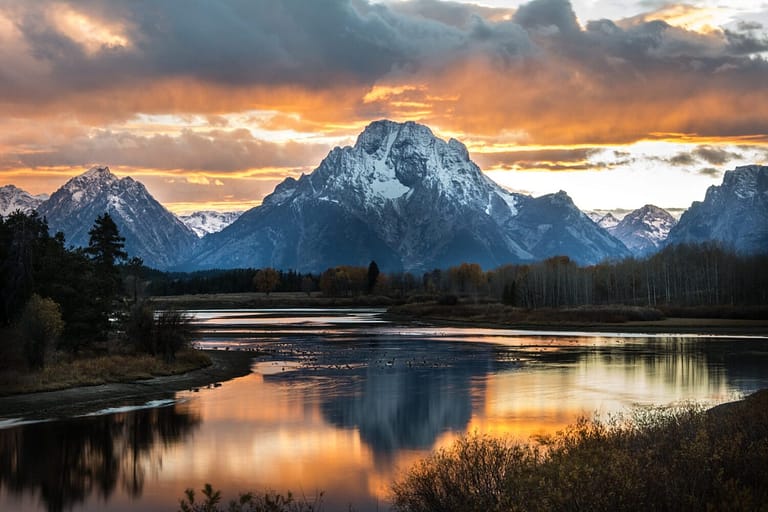Grand Teton National Park is a breathtaking destination that offers visitors a unique opportunity to experience the beauty of the Teton Range and its surrounding wilderness. With its stunning landscapes, abundant wildlife, and numerous outdoor activities, planning a visit to this national park requires some careful consideration. To help you make the most of your time in Grand Teton, we have put together a sample itinerary that highlights the park’s top attractions and activities.
Introduction to Grand Teton National Park
Located in northwestern Wyoming, Grand Teton National Park is renowned for its majestic mountain peaks, pristine lakes, and diverse wildlife. Encompassing over 300,000 acres, the park offers a wide range of recreational opportunities for nature enthusiasts, including hiking, boating, fishing, camping, and wildlife viewing. Whether you are an avid outdoors person or simply appreciate stunning natural scenery, Grand Teton has something to offer for everyone.
Grand Teton National Park is a true gem of the American West. Nestled in the heart of the Rocky Mountains, it is a place where rugged beauty meets tranquility. The park’s landscape is dominated by the Teton Range, a towering mountain range that stretches for 40 miles. These majestic peaks, with their sharp and jagged edges, create a dramatic backdrop against the clear blue sky.
But it’s not just the mountains that make Grand Teton National Park special. The park is also home to a network of pristine lakes, including Jackson Lake and Jenny Lake. These crystal-clear bodies of water reflect the surrounding mountains, creating picture-perfect scenes that will leave you in awe. Whether you want to paddle across the calm waters or simply sit by the shore and take in the view, the lakes of Grand Teton offer a sense of serenity that is hard to find elsewhere.
Overview of Grand Teton National Park
Grand Teton National Park is situated just south of the larger Yellowstone National Park, making it a perfect addition to any itinerary for those planning a trip to this region. The park features the iconic Teton Range, a dramatic mountain range that rises abruptly from the valley floor. With its jagged peaks and unspoiled wilderness, the Teton Range offers endless opportunities for adventure.
As you explore the park, you’ll encounter a variety of ecosystems, each with its own unique flora and fauna. From dense forests of pine and fir trees to expansive meadows filled with wildflowers, Grand Teton is a haven for biodiversity. Keep your eyes peeled for wildlife sightings – the park is home to grizzly bears, black bears, elk, moose, bison, and numerous bird species. Imagine the thrill of spotting a majestic elk grazing in a meadow or catching a glimpse of a bear foraging for food.
One of the park’s most popular attractions is the Snake River, which winds its way through the valley. This iconic river offers opportunities for scenic float trips, where you can leisurely drift along the water, taking in the breathtaking views of the mountains and the surrounding landscape. It’s a chance to immerse yourself in nature and experience the tranquility of the park from a different perspective.
Best Time to Visit Grand Teton National Park
The best time to visit Grand Teton National Park largely depends on your personal preferences and the activities you wish to engage in. However, the months of June to September are generally considered the prime season for outdoor recreation, as the weather is mild and most facilities are open. During this time, the park’s hiking trails are accessible, and the lakes are perfect for boating and fishing.
If you prefer a quieter experience and can tolerate colder temperatures, visiting during the shoulder seasons of spring and fall can be equally rewarding. The park’s landscapes are stunning during these times, and the wildlife is often more active. Imagine walking through a forest of golden aspens in the fall, with the sound of bugling elk echoing in the distance. Or picture yourself surrounded by a sea of wildflowers in the spring, as the park comes alive with vibrant colors.
Winter is also a magical time to visit Grand Teton National Park. The snow-covered mountains create a winter wonderland, and the park offers opportunities for cross-country skiing and snowshoeing. Imagine gliding across the glistening snow, with the crisp mountain air filling your lungs. It’s a chance to experience the park in a completely different way and witness the beauty of nature in its frozen form.
Day 1: Getting Acquainted with the Park
Arrival and Accommodation
Upon arriving at Grand Teton National Park, you can start your adventure by checking into one of the park’s many lodges or campgrounds. Whether you prefer the comfort of a cozy cabin or the simplicity of sleeping under the stars, the park offers a range of accommodation options to suit every traveler’s needs.
Once settled, take some time to familiarize yourself with the park’s layout and visitor center. The visitor center provides valuable information on the park’s geology, history, and wildlife. Rangers are available to answer any questions you may have and can offer guidance on the best trails and activities for your interests.
As you explore the park’s layout, you’ll discover the stunning beauty of the Teton Range, which dominates the park’s skyline. These majestic peaks, reaching heights of over 13,000 feet, are a sight to behold. The jagged peaks are the result of tectonic activity that occurred millions of years ago, shaping the landscape we see today.
Grand Teton National Park is not only known for its breathtaking mountain scenery but also for its abundant wildlife. Keep your eyes peeled for a chance to spot some of the park’s iconic residents, such as elk, moose, and bison. If you’re lucky, you may even catch a glimpse of a grizzly bear or a gray wolf, although these sightings are rarer.
For those interested in the park’s history, the visitor center offers fascinating exhibits and displays. Learn about the Native American tribes that once called this area home and how they lived in harmony with the land. Discover the stories of the early European explorers and fur trappers who ventured into the unknown wilderness of the Grand Tetons.
After soaking up the knowledge and history at the visitor center, it’s time to hit the trails. Grand Teton National Park boasts an extensive network of hiking trails, catering to all skill levels. Whether you’re a seasoned hiker or a beginner, there’s a trail for you. Lace up your hiking boots and embark on an adventure through lush meadows, dense forests, and alpine terrain.
As you hike, keep your camera ready to capture the beauty that surrounds you. From vibrant wildflowers to crystal-clear mountain lakes, there’s no shortage of photo opportunities. Take a moment to sit by the shore of a serene lake and soak in the tranquility of nature.
As the day comes to an end, head back to your chosen accommodation and relax. Whether you choose to unwind by a crackling campfire or enjoy the comfort of a hot shower in your lodge, take a moment to reflect on the day’s adventures. Tomorrow holds even more excitement as you delve deeper into the wonders of Grand Teton National Park.
Day 2: Hiking and Wildlife Viewing
Recommended Hiking Trails
One of the best ways to experience the beauty of Grand Teton National Park is by hiking its scenic trails. With trails ranging from easy strolls to challenging hikes, there is something for every level of hiker. Some popular trails include the Cascade Canyon Trail, Taggart Lake Trail, and the Jenny Lake Loop Trail.
It’s important to note that hiking in bear country requires extra precautions. Be sure to bring bear spray, make noise on the trail, and hike in groups. Following these guidelines will help ensure a safe and enjoyable hiking experience.
Wildlife Spotting Tips
Grand Teton National Park is home to a rich variety of wildlife, and with a little luck and patience, you might spot some of its iconic inhabitants. Keep your eyes peeled for elk grazing in the meadows, moose wading in the lakes, and bison roaming the valleys. Additionally, the park is a haven for birdwatchers, with over 300 species of birds recorded.
Remember to maintain a safe distance from wildlife and never approach or feed them. Observing animals in their natural habitat is a privilege, and we must be respectful of their space and behavior.
Day 3: Lake Activities and Scenic Drives
Boating and Fishing on the Lakes
Grand Teton National Park is home to several stunning lakes, including Jackson Lake and Jenny Lake. These lakes offer a variety of boating and fishing opportunities. Rent a kayak or canoe to explore the crystal-clear waters, or try your luck at fishing for trout.
Whether you’re seeking a tranquil paddle or an exhilarating boat tour, time spent on the lakes is sure to be a highlight of your visit. Just be sure to follow park guidelines and obtain any necessary permits before engaging in these activities.
Must-See Scenic Routes
For those who prefer to take in the park’s beauty from the comfort of their vehicle, there are several scenic drives that provide breathtaking views. The Teton Park Road and the Signal Mountain Summit Road are two popular routes that offer stunning vistas and opportunities to witness wildlife in their natural habitat.
Don’t forget to have your camera ready to capture the awe-inspiring landscapes and wildlife sightings along the way!
Day 4: Historical Sites and Picnicking
Visiting Historical Landmarks
In addition to its natural wonders, Grand Teton National Park is also rich in history and culture. Take some time to explore the park’s historical sites, such as the Menors Ferry Historic District and the Chapel of the Transfiguration. These landmarks provide a glimpse into the park’s past and the people who have shaped its legacy.
Best Picnic Spots in the Park
Before concluding your visit to Grand Teton National Park, take advantage of the park’s picnic areas and enjoy a leisurely meal surrounded by stunning scenery. Some popular picnic spots include the Colter Bay Picnic Area and the String Lake Picnic Area. Take in the fresh mountain air and savor the beauty of your surroundings.
Remember to leave no trace and pack out any waste to help preserve the park’s pristine natural environment.
Conclusion
Grand Teton National Park offers visitors a remarkable opportunity to immerse themselves in the wonders of nature. With its diverse landscapes, abundant wildlife, and range of recreational activities, a visit to this national park is sure to be an unforgettable experience. Whether you are a nature lover, outdoor enthusiast, or simply seeking a peaceful retreat, Grand Teton has it all. So, pack your hiking boots, grab your camera, and embark on an adventure in this awe-inspiring national park.

